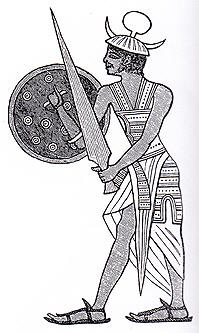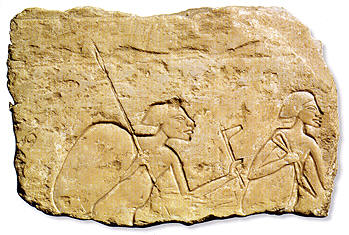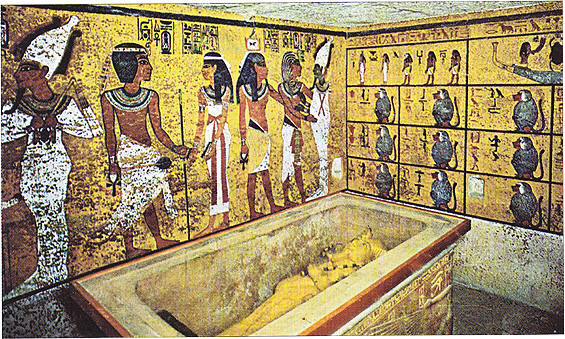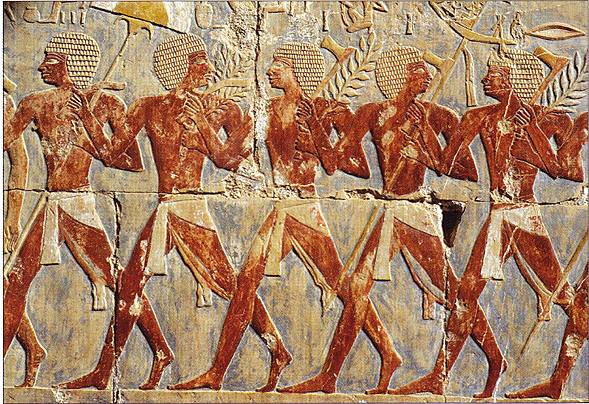Ancient
Egyptian Weapons
The
Egyptian armies of the Old Kingdom (c.2649—2134BC)
and Middle Kingdom (c.2040—1640BC) fought primarily
on foot and in massed ranks. Their soldiers were
lightly equipped with shield, bow, spear and axe.
The constant wars and invasions of the later
dynasties brought with them the assimilation and
transference of diverse military technologies. This
greatly expanded their range of weapons, which
diversified to include plate armor, chariots and,
more importantly, the sword.
Introduction of the Sword
Following the collapse of central government in
Egypt due to internal rebellion, the Hyksos peoples
of Palestine took advantage of this instability and
invaded Egypt around 1640BC. They ruled Egypt for
over 200 years and brought with them striking
advances in weapon making, particularly the use of
metal in the manufacture of swords and edged
weapons.
The adoption of the sword in ancient Egypt was a
direct consequence of the introduction of metal.
Prior to this, axes and spears were fashioned from
flint, and swords were simply not available. Copper
had already been utilized for some time, but bronze
was the first material consistently used for sword
blades, as it was much harder and easier to work.
Sickle-shaped swords (originally inherited from the
Sumerians) were gradually replaced by swords with
slightly curving blades. The “Sea Peoples”, invaders
from the Aegean and Asia Minor who first attacked
Egypt during the reign of Merenptah (1213—1202BC),
also introduced straight, two-edged blades with
sharp, stabbing points. Contemporary depictions of
battles show massed infantry using both jabbing and
slashing
swords.
 The
Influence of Iron The
Influence of Iron
Throughout the Mediterranean during the New Kingdom
period of Rameses III (c.1186—1155BC), the smelting
of iron ore had a direct impact on Egypt, enabling
swords to be produced with much longer and sturdier
blades. Examples of swords with blade lengths of up
to 75cm (30in) have been unearthed from royal tombs.
This ancient Egyptian warrior is depicted carrying a
long, double-edged and broadbladed sword. It is
probably a one-piece construction.
The Spear
Primarily a weapon used for hunting, the Egyptian
spear never surpassed the bow and arrow, which
remained the standard weapon of the Egyptian Army.
During the Old Kingdom (c.2649—2134BC) and Middle
Kingdom (c.2040—1640BC), simple pointed
spearheads were constructed from either flint or
copper and attached to long wooden shafts by means
of a tang (the hidden portion or “tongue” of a blade
running through the handle). In the later New
Kingdom (c.1550—l070BC), stronger bronze
blades were secured by a more reliable socket.
 Spears were made for
either throwing or thrusting, and were especially
useful when chasing fleeing enemies and stabbing
opponents in the back. They were regarded primarily
as auxiliary weapons and called upon by charioteers
when they had spent all their arrows and needed some
form of close protection. The following description
of Amenhotep II’s victory at the Battle of
Shemesh-Edom c.1448BC (in Upper Galilee, now
modern-day
Israel) is recorded at the Temple of Karnak (built
over a period of some 1,600 years from around
l500BC), near Luxor in Egypt: Spears were made for
either throwing or thrusting, and were especially
useful when chasing fleeing enemies and stabbing
opponents in the back. They were regarded primarily
as auxiliary weapons and called upon by charioteers
when they had spent all their arrows and needed some
form of close protection. The following description
of Amenhotep II’s victory at the Battle of
Shemesh-Edom c.1448BC (in Upper Galilee, now
modern-day
Israel) is recorded at the Temple of Karnak (built
over a period of some 1,600 years from around
l500BC), near Luxor in Egypt:
Behold His Majesty was
armed with his weapons and His Majesty fought
like Set in his hour. They gave way when His
Majesty looked at one of them, and they fled.
His Majesty took all their goods himself with
his spear... Karnak Stele of Amenhotep II,
from W.M. Flanders Petrie, A History of
Egypt, Part Two.
ABOVE:
Carved by an unknown Egyptian artist during the 18th
Dynasty, c.1567—1320BC, this relief depicts two
soldiers, one carrying a spear.
The Khepesh -
Sword of the Pharaoh

ABOVE:
An Egyptian bronze khepesh sword with a handle
inlaid with ivory. The sword comes from El Ivory
handle Rabata and dates to the New Kingdom, c.1250BC.
Originally a throwing weapon of sickle-sword shape,
the khepesh could also be used as a conventional
slashing or cutting sword. It appears to have been a
favored weapon of the Pharaoh, as he is often
depicted wielding it against enemies or during a
hunt. The discovery of the tomb of Tutankhamun
(r.c.1361—1352Bc) by Howard Carter in 1922 revealed
remarkable insights into the lives of ancient
Egyptians. One of the numerous objects found in the
tomb included a ceremonial shield, which depicted
the young Pharaoh “smiting a lion” with a khepesh.

ABOVE:
The Tomb of Tutankhamun. The king is depicted in a
number of battle scenes, although it is not known
whether he actually took part in any campaigns.
The Battle-axe
There were two distinct types
of battle-axe used by the Egyptian soldier: the
cutting axe and the piercing axe. The cutting axe,
used during the early kingdoms, had a head attached
to a long handle and would have been used at arm’s
length. The blade head was attached to the handle
through a groove and then tightly bound with leather
or sinew. This axe was especially effective against
opponents who wore little body armor, particularly
Egypt’s African enemies, like the Nubians. It was
usually deployed after the enemy had been routed
(often by the archers), rather than as a weapon
against massed ranks.
The cutting axe was later
superseded by the piercing axe that was designed to
penetrate armor. Unlike contemporary Asiatic
societies (especially the Sumerians and the
Assyrians), who used a blade cast with a hole
through which the handle was inserted and firmly
attached by rivets, the Egyptians continued to use
the antiquated method of a mortise-and-tenon joint
(a tenon is a tongue that slots into a hole called
the mortise) to fix the blade to the handle. This
made the battle-axe inherently weaker. During the
invasion by the Hyksos around 1640Bc, this obsolete
weaponry, coupled with the invaders’ use of
horse-drawn chariots, long swords and stronger bows,
proved fatal for the lightly armed Egyptians.

ABOVE
A painted relief of light infantry with standards,
battle-axes and palm fronds, from the temple of
Hatshepsut in Thebes, Egypt, c.1480BC.
|